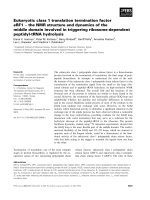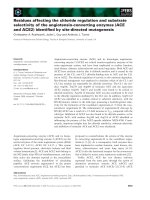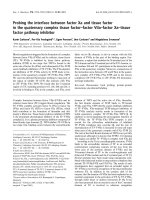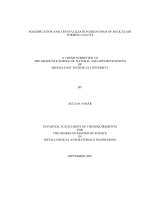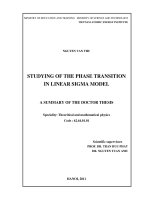Thesis Factor Affecting the efficiency_of_HR_utilization_shopping_centre_managment_HongKong
Bạn đang xem bản rút gọn của tài liệu. Xem và tải ngay bản đầy đủ của tài liệu tại đây (5.51 MB, 217 trang )
FACTORS AFFECTING THE EFFICIENCY
OF
HUMAN RESOURCE UTILIZATION
IN
SHOPPING CENTRE MANAGEMENT
by
HUI WING TO
B.A.A.S., B. Arch. HKU
A thesis submitted in partial fulfilment of the requirements
for the degree of Doctor of Philosophy
at The University of Hong Kong
January 2011
Abstract of thesis entitled
Factors Affecting the Efficiency of Human Resource Utilization
in Shopping Centre Management
Submitted by
HUI Wing To
for the degree of Doctor of Philosophy
at The University of Hong Kong
in January 2011
One of the key factors that determines the success of a shopping centre is how
efficient are its human resources utilized to maximize its value. This study
investigates how corporate business strategies, as reflected in the perceptions and
beliefs of shopping centre managerial staff, affect management efficiency, which
is defined as efficiency of human resource utilization in shopping centre
management.
We measure the management efficiency of a shopping centre’s management by
comparing inputs and outputs using Data Envelopment Analysis (DEA). The
inputs are defined as the different types of human resources utilized to manage a
shopping centre, while outputs are measured by the rental value per floor area
holding a range of exogenous factors constant. These exogenous factors
include location attributes and physical characteristics of the shopping centres.
Data on inputs and the beliefs and perceptions of managerial staff at different
levels were collected by questionnaire surveys followed up by telephone calls
and interviews.
We collected data from 106 shopping centres located along the Mass Transit
Railway lines. At the strategic level, we found that management that focused
on satisfying the needs of shoppers rather than those of tenants was more
efficient.
However, whether management adopted a centralized or
decentralized approach to shopping centre management had no impact on
management efficiency. Management that aimed to maximize short term rental
income and that which focused on achieving longer term branding effects had
similar levels of management efficiency.
For leasing and marketing management, we found that management that focused
on achieving a planned optimal tenant mix was more efficient. Contrary to
most people’s beliefs, management that believed in maximizing customer flow
was less efficient. Our empirical data also suggested that the professional
qualifications of leasing and marketing staff were not important as far as the
efficiency of shopping centre management was concerned.
At the operational level of property and facilities management, we found that
shopping centres were more efficiently managed if management at this level
believed that professional qualifications were important for property and
facilities management, which was in sharp contrast with the findings for leasing
and marketing management. We also found that management that aimed to
control costs within budget and that which aimed to create value did not differ
significantly from each other in terms of management efficiency. Finally,
although property and facilities management were at the technical level of
overseeing the physical structure, management that believed in satisfying users’
needs more than merely maintaining the physical conditions of the property
tended to achieve higher management efficiency.
DECLARATION
I declare that the thesis and the research work thereof represent my own work,
except where due acknowledgement is made, and that it has not been previously
included in a thesis, dissertation or report submitted to this University or to any
other institution for a degree, diploma or other qualifications.
Signed ……………………………………………..
HUI Wing To
i
ACKNOWLEDGEMENT
I must first thank the University of Hong Kong for providing such precious
opportunity allowing academics, in particular myself, to be able to further my
educational goals, to carry out my research under the renowned Department of
Real Estate & Construction, with a distinct advantage. Profound thanks!
To two splendid inspiring supporters of my cause: Professor K.W. Chau and
Professor W.S. Wong:
For the superlative intellectual guidance and genuine dedication of
Professor Chau, for the competent role and ardent support of Professor Wong,
may I extend my cordial appreciation of my highest respect and admiration well
deserved.
Since the formulation of my research topic, Professor Chau had helped me
through the choice of various unique and pragmatic issues, inspiration in
bringing forth new insight into the real estate industry, thus taking shape in
reaching full potentials of my research, with specification to the emerging needs
and aspirations of a worldedge real-estate sector.
Without Professor Chau's valuable suggestions of studies, options of research
methods and stimulating thoughts of analysis, this work of mine could not have
permitted me to interpret the spirit to the letter.
Therefore, to Professor Chau my utmost gratitude for enabling me to contribute
to the academic and professional sectors through this journey.
Correspondingly, Professor Wong has exemplified genuine scholarship that has
an extreme appeal for my aspiration, inspiring me to full realization of the inner
satisfaction of research writing, and most encouragingly for availing me with
several occasions to deliver lectures to HKU students and China Study Groups
on related topics, thus making it possible for my research database reinforced,
compatible with positive interactions with students and real estate stakeholders
considerably gained.
ii
With Professor Wong's kindness, I can continue to serve the needs and
aspirations in my profession, a focal point in the light of my task of undertaking.
My sincerest gratitude to Professor Wong!
I am also grateful to the Developers and Corporations, of course, for sharing with
me their business strategies and tactics, management characteristics, Company
executives' time and efforts, moreover individual experiences and insight of
Company policies, over personal as well as telephone dialogues, the returns of
questionnaires, all of which are of paramount significance in fulfilling my
data-mine process, in a broad research agenda.
Last but not the least, I am beholden to my better half sharing the truest bond
with me, for her unfailing caring throughout, in consolidating my strength and
determination in times of sickness and downbeat, and at the end of stressful
days where I can find serene peace to unburden myself, precisely work through
the setbacks, as I strive on maintaining the hectic operation of my professional
practice. Thank you Grace!
John Wing-to HUI
iii
TABLE OF CONTENTS
Page
Declaration………...……………………………………………………………..i
Acknowledgement……………………………………………………………....ii
Table of Contents……………………………………………………….….…...iv
List of Figures…………………………………………………………..………ix
List of Tables………………………………………………………………….…x
CHAPTER 1
INTRODUCTION…………..…………………………..……………....………1
1.1 Background Information………………………………………….......…..1
1.2 Retail and Shopping Centre Industry in Hong Kong…….……...………..4
1.3 Shopping Centre Management as a Unique Type of
Business Management……………...………………..…………..…...…..7
1.4
Characteristics of Professional Shopping Centre Management….….….13
1.5 Objectives of the Research………….………..……………..….…….…15
1.6 Context of Research……………….…...……...…………...……….…..17
1.7 The Research Issues……………….…...………………..……..…...…..20
1.8 Research Motivation………...……….………………....……….………21
1.9 Importance of the Research…….…………………….…..…….……….22
1.10 Organization of the Thesis…………………….…...………..…….....…..22
iv
CHAPTER 2
LITERATURE REVIEW…...………………………………………...………24
2.1
Conventional and Contemporary Retail Objectives Overview….….......24
2.2
Real Estate (RE) Professional Services Overview………….….....…….26
2.3 On Human Resource Demand and Management….........…............……29
2.4 On Management Strategies and Professional Services………….…....…34
2.5 On Professional Property and Shopping Centre Management…...….….35
2.6 Efficiency in Business and Shopping Centre Management…..……..…..45
CHAPTER 3
EXPLORATORY STUDY……………………………………………....……49
3.1 Preliminary Investigations and Selections for Research..…....................49
3.2
Field Surveys of Physical Attributes………….……...…………….…...53
3.3
Corporate Level Business Strategies and
Management Characteristics of Shopping Centres……..……................59
3.4
Corporate Level Human Resource Utilization Strategies……....…....…62
3.5
Centre Level Human Resource Utilization Strategies………………….63
3.6
Property Management System and Outsourcing Situations……….…...65
3.7
Renovation / Maintenance (R/M) Frequency vs Age of Centre…….….66
3.8 Styles, Design and Development Considerations of Shopping
Centres…………….………….………….………………………...……67
v
3.9
Factors affecting Shopping Centre Management.……….………..……69
3.10 Management Organization Charts……….……….……………...…..…84
CHAPTER 4
DEVELOPMENT OF HYPOTHESES.....................…………………….......88
4.1
Analysis of Human Resource Utilization of
Shopping Centre Management…………………………...………..……89
4.2
Hypotheses Of Management Efficiency…….………....……….....……..93
4.3
.
4.4
The Dependant Variable…………………….….…….….……..……......97
4.5
Summary of Hypotheses……………………….…….……...…… ……118
The Independent Variables.….…………….…………..…...…..………..98
CHAPTER 5
RESEARCH DESIGN AND METHODOLOGY…………………...……..119
5.1
Statistical Analysis Of Data………………………………………...…..119
5.2
Step 1……..………………………..……………………….………......120
5.3
Step 2……………………………………………………….……..……123
5.4
Step 3…………………………………………………….……..………129
vi
CHAPTER 6
DATA AND SOURCES…………...…………………………………………133
6.1
Sourcing and Mining of Data…………………….………...……..…….133
6.2
Further Investigation of Shopping Centre Management
Characteristics and Human Resource Allocation……….……...…..…..134
6.3
Weighting Analysis…………………...….…………………..…………142
6.4
Discussion of Collected Data…………………………......…………….153
CHAPTER 7
RESULTS AND DISCUSSIONS………………………………..………..….162
7.1 Empirical Result of Step 1…………………………………….….…..….162
7.2 Discussion of Results of Step 1…………………………...……………..163
7.3 Empirical Result of Step 2…………………………………..………...…167
7.4 Discussion of Results of Step 2…………….………...………….......…..169
7.5
Empirical Result of Step 3……..……………...…….……………..…… 170
7.6 Discussion of Results of Step 3……………….…………………………171
.
7.7 Control Variables of Physical Attributes………….…...……….…..……179
7.8
Discussion of Overall Results………………………………….………...180
vii
CHAPTER 8
CONCLUSION……………………………………………………….………182
8.1
Analytical Summary of Findings…….………………...….………..……182
8.2
Contribution of the Study……………….…………..…...………..……..183
8.3 Limitations………………………………….………...………..…..….…184
8.4
Areas of Further Studies……………………..………………..….…..….186
REFERENCES……………………...………….…………………................ 189
APPENDICES………………………...………………..…………….……….196
viii
LIST OF FIGURES
Page
Figure 1-1
Elements shaping Shopping Centre Design…………….......
11
Figure 3-1
Diagram of knowledge required and functions of the
‘shopping centre management professional CEO’………….
62
Figure 3-2
Diagram of a Typical Catchment ...........................................
74
Figure 4-1
Factors affecting Shopping Centre Sales Performance……
96
Figure 4-2
Different Approaches to Information Systems
Responsibilities……………………………………………... 102
Figure 5-1
Key Determinants of Shopping Centre Rental…………....... 121
Figure 7-1
Efficiency Scores Chart ……………………………………... 167
Figure 7-2
Efficiency Score Frequency Chart………….......................... 168
ix
LIST OF TABLES
Page
Table 2-1
Manpower Projection of the Real Estate Services Industry
in 2010 to 2012…………………………………….…………… 28
Table 3-1
Notes For Discussion In Pre-Survey Interviews……............... 55
Table 3-2
Notes For Initial Research Of Shopping Centres………..…..
56
Table 3-3
Factors Exogenous and Endogenous To Shopping Centre
Management……………………………………………………
69
Management Strategies of Different Hierarchies of
Shopping Centres………………………………..……………
81
Table 3.5 Management Organization Chart………………………...….
84
Table 3-4
Table 3-6
Table 4-1
Table 4-2
Human Resource Allocations for ALL Shopping Centres
under the Corporation……………………………………......
85
Inputs and Outputs of HR Planning in Shopping Centre
Management……………………………………………………
90
Hierarchies of Human Resources in Shopping Centre
Management……………………………………………………
93
Table 4-3
Measurement of Successfulness of Shopping Centres……….
Table 4-4
Summary of Hypothesis……………..……………………….. 119
Table 5-1
References of 2-Stage DEA ……………………………..……. 126
Table 5-2
Quantifying Input of Levels of HR…………………………… 127
Table 5-3
Shopping Centre Management Characteristics…………….. 130
Table 5.4
Expected results………………………………..…………….... 132
Table 6-1
Descriptive Statistics of Step 1 Model…………………........... 133
Table 6-2
Research Questionnaire………………………………………. 136
Table 6.3
Sample of Data Collected…………………………………….... 141
x
94
Table6-4
Sample Chart for Priorities in Human Resource
Allocations……………………………………………………...
147
Table 6-5
Sample of Professional HR Weighting by no. of Shops…….. 151
Table 6-6
Sample of Professional HR Weighting by Area of Shops…... 152
Table 6.7
Descriptive Statistics of Step 3 Model……………………...… 153
Table 7-1 Step 1 Model Empirical Results……………………………… 163
Table 7.2
DEA Scores With Unity Management Efficiency…………… 168
Table 7-3
Step 3 Model Empirical Results……………………………… 171
xi
CHAPTER 1
INTRODUCTION
This introductory chapter describes the motivation and importance that lead to the
embarkation of this research.
Background of the shopping centre industry, convoy of
management professionals behind, relationship between retail developments and
deployment of real estate professionals will be discussed.
The objective and the
prospective significance that this research can bring to the industry and the real estate
economy as a whole, will be emphasized.
Some Key Words highlighting the gist of this research are identified as follows : Real Estate Professionals
Shopping Centre Management
Human Resource utilization
Management Efficiency
'Successfulness' of shopping centres
1.1 Background Information
1.1.1
Real Estate Professional Services (REPS) in Hong Kong
Through the natural and gradual transitioning of Hong Kong’s economic
structure since the 80’s, service industries have taken a major shape in Hong
Kong’s Domestic Products. The demand of REPS is different in various
disciplines due to the stage when services of these disciplines enter the process
of real estate developments.
1
In this research, Real Estate Professionals can be defined as :
Managerial personnel who have attained recognized qualifications in
professional institutions related to real estate development activities; and
Executive personnel of other accredited qualifications but possess prolonged
and vast managerial experience in real estate development.
Real Estate Administrators, Planners, Architects, Estate surveyors are first to be
seen in the early stage of development. Next at the implementation of design,
contracting and construction are Architects, Engineers, Quantity Surveyors
being appointed, and finally upon completion of the project, Property and
Facilities Managers enter the picture. It has been through years of progress in
property development in the last three decades when professionals have evolved
to become executives by appointments, and furtheron, promoted as
decision-makers in the field.
The volume of engagement of all these disciplines quite depends on the
developers’ intention whether to develop new or revitalized old projects that are,
in turn, subject to anticipation of a disposable market situation, at the increase
path of property price or when the supply is conjectured to diminish.
Therefore, the demand of these REPS would be related to the Domestic Product
of real estate industry in Hong Kong, alongwith the rate of increase of new
properties in the market.
Over the past 10 years the number of newly completed flats was 265,000,
representing a 25.2% increase as compared to 1,050,800 in 2001. The area of
commercial space completed same period was 3,635,000m2 as compared to area
9,161,700m2 in 2001, a 39.7% increase. Given the circumstance the demand
for REPS and Real Estate Professionals had risen sharply to meet with the
booming development in the late 80’s and the 90’s respectively.
In reality, the demand of Real Estate Professionals is subject to several
open-ended factors and cross-related variables. For instance, demand for local
Real Estate Professionals was acute in Mainland China when development
opportunities were building up after 1997 but then later turned around under
various regulatory measures engaged to cool down the industry over boom in
some cities. Overtime, projects were picking up again shortly after China’s
accession up to WTO, and furtheron success in hosting the 2008 Olympics, the
2010 Expo in Shanghai.
This phenomenon signifies the pulling effect of each city varies and it would be
intricate to generalize formulation of a demand model of Real Estate
Professionals against disciplines of variability.
2
1.1.2 Property and Facility Management
On the other hand, demand of other REPS like property managers depends more
on the total number of existing domestic and commercial/retailing developments.
For residential blocks, about 60 % of existing stock is with Property
Management (PM) services. This stock profile is much larger than that of new
residential blocks completed per annum. Thus increase in demand would be
related to higher quality of services expected, Government policy to encourage
or mandate PM services, and new projects constructed.
Property and Facility Management is one of the key roles in maintaining and
up-keeping real estate properties and facilities to manifest effective usage and
sustainable business operation especially for commercial and retail properties.
There are diverse and controversial definitions of Facility Management and
Property Management that need be clarified and defined within the context of
this study, vide infra:
Practising Property Management professionals declare that Facility Management
is included in the real estate management of Property Management.
However,, Facility Management promoters proclaim that it is a broad profession
which involves wide spectrum of fixed assets and intellectual properties in that
Property Management is merely one of its disciplines.
Definition by the Hong Kong Institute of Facility Management (HKIFM (2000))
referred as‘facility management is the science and art of managing this
integrative process from operational to strategic levels for promoting the
competitiveness of organizations.’
As such, after due consideration for the purpose of this study, the context of
Property and Facility Management is deliberated to be confined to the
management of physical retail properties and ancillary facilities including
building and information services.
1.1.3
Demand of
Professionals
Property
and
Facility
Management
(PM/FM)
Quite different from other real estate professionals, Demand of PM / FM
professionals, depends on the following factors :Tangible :
1 No. of existing Buildings with Owners’ Corporations, Mutual Aid
Committees, Management Committees
2 No. of Property Management Companies
3 New developments
4 New legislation
5 Age of buildings
3
Intangible :
1 Improvement in living Quality
2 Complexity of social interactions
3 Weight of third party liabilities
4 Need of up-keeping of security
5 Professional advice and administration of maintenance work
In Hong Kong, the development of professional property management only
dated back to the sixties, benchmarked by the establishment of the Chartered
Institute Housing, Hong Kong Branch in 1966 (later officially renamed as the
Asian Pacific Branch in 2001).
The Property and Facility Management Division of the Hong Kong Institute of
Surveyors was established in 2005, in response to the growing demand for
surveyors’ specialized services in property and facility management.
1.2 Retail and Shopping Centre Industry in Hong Kong
1.2.1 Evolution of Shopping Centre Industry in Hong Kong
Since the nineteenth century, some of the English retail traders took foot-hold in
Hong Kong. Established in 1850 by Scotsmen, Lane Crawford was originally a
ship chandler in Hong Kong, now distribution of stores is strategically placed in
the heart of the city’s prime locations.
At the beginning of the twentieth century, Chinese entrepreneurs migrated to
Hong Kong and established ‘old trade marks’ of retail businesses, bringing along
capitals and vast experience in running large scale department stores that had
been thriving in Shanghai. Among them was the well known Sincere
Department Store established in Hong Kong in 1900, to be followed by Wing On
Department Store in 1907.
Not long thereafter, state-owned enterprises of the Peoples Republic of China
began to take hold in the retail industry as well. Evolving from the business
mode of ‘friendship stores’ in the Mainland, one of the oldest traditional Chinese
emporiums was CRC Department Store first established in 1930 under China
Resources, and later in 1959 another Yue Hwa Chinese Emporium was set up in
operation.
4
‘Traditional street retail within mixed use zones has been the norm since the
city began to grow under British occupation in the 19th century. It was only in
the 1960s that shopping malls appeared in the city’(Irazabal C.(Prof) et al
(2007). The brief statement has reflected the general historical account of local
department store and shopping centre industry. Indeed, it was the opening of
the Ocean Terminal in 1966 that had marked the commencement of Hong
Kong’s greater mall phenomenon.
1.2.2 Characteristics of Shopping Centres in Hong Kong
In an article of The Standard (2005) ‘Reach for the sky’, an expert in the industry
Heung brought up the trend of shopping centres in Hong Kong that `Vertical' is a
good option for developers looking to maximize retail floor space,’ and ‘The
trend towards "vertical centres" - shopping malls similar to APM in Kwun Tong
and Langham Place in Mong Kok - is set to continue’. Four other vertical
centres are on the way including Tung Ying Building and I-Square in Tsim Sha
Tsui.
According to his estimates, ‘APM and Langham Place have floor plates of about
50,000 sq ft and 60,000 sq ft, respectively. Strictly speaking, vertical centres
have characteristics of a small floor plate of about 40,000 to 50,000 sq ft and a
vertical shopping mall. The first vertical shopping centre in Hong Kong is
Times Square.’
From the above, it appears that ‘Vertical’ has become one of the recent trends or
solutions, that is to build large scale malls on sites of limited footprint in Hong
Kong.
However, Shopping Centres are not sheerly signified by their heights but
necessarily by the unique designs and tasteful atmosphere of major malls created
by renowned architects and designers; orderly and well organized public spaces
facilitated by professional property managers; dynamic tenant mix with price
worthy merchandise motivated by experienced marketing directors; and most of
all, commitment of customer-centred service pledge upheld by developers and
centre management.
5
Other significant typical characteristics of district malls include location at
commercial podiums of residential or commercial developments; incorporation
of food court with Eastern and Western styles of cuisine; proximity to major
traffic nodes; and quite popular in newly developed housing estate clusters,
linked up by pedestrian footbridges.
Irazabal C. (Prof) et al, (2007)’s description of major shopping centres in Hong
Kong as Entertainment-Retail Centres (ERC) as ‘ transit-oriented ERCs are a
result of strategic planning and public-private partnerships’ is a vivid
illustration of one of the major characters, ’ as seen in Pacific Place and other
similar centers (such as the International Financial Center or IFC Mall and
Skywalk) are a way of life in Hong Kong because they are fully integrated into
the functions of everyday life and the regular pathways of many pedestrians.’
This has described the very unique feature of Hong Kong shopping centres’
amalgamation into mass transit nodes and hubs.
In broader perspective, 'Successfulness' of shopping centres can be identified
as: a qualitative measure of achieving the desired business goals in the operation
of shopping centres, coupled with a quantitative measure of profitability in terms
of revenue return and added value of the retail property.
1.2.3 Categories of shopping centres
There are established grouping systems of shopping centres in many of the
developed countries with relatively longer history of shopping centre/mall
developments such as the United States, Europe and Australia.
For instance, the National Research Bureau’s Shopping Center Directory, USA
(1999) has introduced the following types of shopping centres:
(1) Community centre, averaging 150,000SF, that has a wide range of soft and
hard lines and is usually anchored by a department or discount store;
(2) Neighbourhood centre, often around 50,000SF and anchored by a grocery;
(3) Power centre with 3 to 5 “big box” anchors and relatively few small stores;
(4) Regional shopping centre averaging 400,000SF with 2 or 3 department
store anchors; and,
(5) Super Regional Centre, often 1.0 million SF or more.
6
On the other hand, the ICSC (International Council of Shopping Centres) has a
definition slightly different from the above, viz:
(Source: ICSC Research Quarterly V. 8, No. 2—Summer 2001)
(1) Neighbourhood Centre Convenience 30,000–150,000 SF with 1 or more
anchors.
(2) Community Centre General Merchandise; 100,000–350,000SF with 2 or
more anchors.
(3) Regional Centre General merchandise; fashion 400,000–800,000SF with 2
or more anchors.
(4) Super-regional Centre Similar to regional centre but 800,000+SF with 3 or
more anchors.
(5) Fashion/Specialty Higher end; fashion oriented 80,000–250,000SF.
(6) Power Centre Category-dominant anchors; 250,000–600,000SF with 3 or
more anchors.
(7) Theme/Festival Centre Leisure; tourist-oriented; 80,000–250,000SF.
(8) Outlet Centre Manufacturers’ outlet stores 50,000–400,000SF.
Whereas in Australia, the major categories of retail floor space include:
(1) Central Business District (CBD) shopping space in city centres;
(2) Regional shopping centres or department store centres;
(3) Sub-regional shopping centres, or discount department store centres;
(4) Supermarket shopping centres; and
(5) Traditional strip shopping centres in a town or suburb.
1.3 Shopping Centre Management as a unique type of Business
Management
Professional management of a business operation opts for competent and proficient
management skills exerted by experienced and sensible personnel with recognised
professional qualifications and importantly, sense of integrity.
In brief, Business Management can be defined as :
7
Influencing of people to help accomplish the goals of an organization and
business. It involves planning, organizing, and guiding employees and
activities surrounding these events.* ()
Historically, the evolution of Business Management has based from the simple ‘act of
the managers’ risen to complex and inter-correlated categories in terms of various
processes, tasks, and objects of business activities.
Towards the end of the 20th century, business management arrived to a classification
of six separate branches, namely:
Human resource management
Operations management or production management
Strategic management
Marketing management
Financial management
Information technology management
In the 21st century observers find it increasingly difficult to subdivide management
into functional categories in this way. More and more processes simultaneously
involve several categories. * ( />Rightly so, shopping centre management is factually a very special type of business
that encompasses the above six categories of management and its actual operation
would embark on goals, targets and tasks that simultaneously involve a combination of
most, or all of them.
Serving the purpose of this research, hereby Shopping Centre Management is
defined as :
“a specialized scope of business management that encompasses management of
human resources, operations, business strategies, marketing, finance information,
all elements of which are essential for achieving the successful business goals of
shopping centres.”
8
1.3.1 Corporate Culture - the Four Ps’ applicable to Shopping Centre
Management
"All companies have a culture, a way they behave and operate. In order for
employees to function and succeed, it is essential they understand and believe in
the culture. Corporate culture pertains to the identity and personality of the
company we work with, either in the private or public sectors.’(Ezinearticles,
Bryce T.(2oo6)
It was emphasized that the Corporate Culture, being ‘a vital part of the art
management’ could exercise a strong power on the successfulness of
people-oriented function.
(Source:http//ezinearticles.com/Understanding-Corporate-Culture&id=211379)
ARINC (Aeronautical Radio, Inc.), a global company (headquartered in
Annapolis, Maryland, USA) advocates itself as ‘a solutions company built on
four enduring hallmarks: people…purpose…passion…performance’.
The four ‘P’s’ coincidentally and precisely outlined the objectives or target issues
that real estate and shopping centre managements are looking for, and can be
reinterpreted as follows: PEOPLE : For those serving the shopping centre, appropriate human
resource management policies be adopted. For those being serviced,
appropriate customer relationship management be provided.
PURPOSE : Asset enhancement, value adding to real estates, quality
management and customer satisfaction.
PASSION : To uphold the core values and exceptional qualities of people
and the corporation, to maintain delivery of quality services, customer
priorities, innovative problem-solving, caringness within the corporation
and the community at large, and most of all, a constant drive for continuous
improvements.
PERFORMANCE : Competitiveness upkeep while preserving quality;
monitoring and rewarding the able; providing good corporate governance;
seeking value-adding alternatives and options, and the best optimum level
of operational and business efficiency through viable strategies and
competent professional management.
9
1.3.2 Corporate Business Strategy and Shopping Centre Development
Shopping centre development of a corporation, especially for listed companies,
is often classified as fixed property assets able to generate long-term revenue for
the company.
Under the retail property profile, the development and management of shopping
centres would largely depend on the execution of business strategies, which
should entail the choice of locations, allocation of financial and human resources,
adoption of development concept and market positioning, and ultimately the
evolvement of management characteristics of a shopping centre.
1.3.3 Shopping Centre Design, Management Quality and Customer
Preferences
In recent years, the key to successful shopping centre development hinges on the
capturing of the surging purchasing habits, customer characteristics and most
crucially, the life style of the major group of target customers.
Take a landmark development: the Langham Place, an article of The Standard
(2005), as remarked:
‘To overcome the natural tendency of shoppers to move horizontally and
not upwards, vertical centres used express escalators to reduce the time for
shoppers going from floor to floor. Architectural features like the Digital
Sky on level 13 covering the dining area of Langham Place also helped to
attract visitors. Special events are also used to draw visitors’’
In fact, whatever the concept developed for the design of a shopping centre, the
key objective is to explore opportunities and options to build up an image to
match with, or to lead the way of potential customers, to a new shopping
experience compatible to their purchasing power, characteristics and lifestyle.
Naturally, major considerations would be the physical constraints, yet what can
be considered more crucial are the intangible constraints that would mould the
10
quality of ‘shoppertainment’ experience that can be created for, and perceived by
the customers.
Thus in essence, business strategies, customer preferences, physical design
concept and the centre management policies are the four key interactive elements,
the ‘soft wares’ that shape the ‘hardware’ of a shopping centre as illustrated in
the bubble chart below.
Fig. 1-1 Elements shaping Shopping Centre Design
customer
preferences
business
strategies
SHOPPING
CENTRE
DESIGN
physical
design
concept
centre
management
policies
1.3.4 Shopping Centre Management as an emerging profession
In the annual report of The Link REIT (2006), the Role of The Manager has been
elaborated as –
‘The Manager is responsible for managing the portfolio of 180 properties.
As at 30 September 2006, the Manager had 326 staff. Key activities of the
Manager include leasing, property management, enhancement and
maintenance works, investment and fund management and associated
corporate services.’
In an Australian recruitment web site on the role of a Retail Centre Manager:
11


